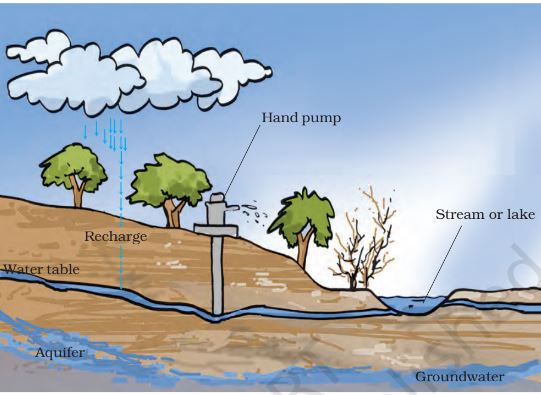NCERT CLASS 7 SCIENCE CHAPTER 16 WATER, A PRECIOUS RESOURCE
Download Pdf
NCERT CLASS 7 SCIENCE CHAPTER 16 WATER, A PRECIOUS RESOURCE
Online Lecture
NCERT CLASS 7 SCIENCE CHAPTER 16 WATER, A PRECIOUS RESOURCE
Question Answers
NCERT IN – TEXT QUESTIONS OF BOOJHO AND PAHELI
Q.1 Mark ‘T’ if the statement is true and ‘F’ if it is false:
(a) The fresh water stored in the ground is much more than that present in the rivers and lakes of the world.(T/F)
(b) Water shortage is a problem faced only by people living in rural areas.(T/F)
(c) Water from rivers is the only source for irrigation in the fields. (T/F)
(d) Rain is the ultimate source of water.(T/F)
Ans. (a) True (T); (b) False (F); (c) False (F); (d) True (T).
Q.2 Explain how groundwater is recharged?
Ans. The ground water get recharged through the process of infiltration. The infiltration means séeping in water from rain, rivers and lakes into the empty spaces and cracks deep below the ground.
Q.3 There are ten tubewells in a lane of fifty houses. What could be the long term impact on the water table?
Ans. The effect on the water table depends on the replenishment of the underground water. As only five families will share a tubewell, the water used for daily domestic purpose will not effect the water table as such. But if there is a acute shortage of rains, the water used by the families will not replenished and water table will fall down.
Q.4 You have been asked to maintain a garden. How will you minimise the use of water?
Ans. By collecting rain water. Also to minimise the wastage of water, we will use the new technique of drip irrigation, which directly throws water at the base of plants.
Q.5 Explain the factors responsible for the depletion of water table.
Ans. Increasing population: Increasing population creates demand for construction of houses, shops, offices, roads and pavements. This decreases the open areas like parks and playground. This in turn, decreases the seepage of rainwater into the ground. What could be the consequence? Recall that pukka floor does not allow water to seep in easily, while in a grass lawn water seeps through in no time.
Moreover, a huge amount of water is required for construction work. Often groundwater is used for this purpose.
So, on the one hand we are consuming more groundwater, and on the other, we are allowing lesser water to seep into the ground. This results in depletion of water table. In fact, the water table in some parts of many cities has gone down to alarmingly low levels.
Increasing industries: Water is used by all the industries. Almost everything that we use needs water somewhere in its production process. The number of industries is increasing continuously. Water used by most of the industries is drawn from the ground.
Agriculture activities: A majority of farmers in India depend upon rains for irrigating their crops. Irrigation systems such as canals are there only in a few places. Even these systems may suffer from lack of water due to erratic rainfall. Therefore, farmers have to use groundwater for irrigation. Population pressure on agriculture forces increasing use of groundwater day- by -day. This results in depletion of water table.
Q.6 Fill in the blanks with the appropriate answers:
(a) People obtain groundwater through………and……….
(b) Three forms of water are…….. , …………..and…………
(c) The water bearing layer of the Earth is………….
(d) The process of water seepage into the ground is called…………..
Ans. (a) well and handpumps. (b) solid (ice), liquid (water), gas (water vapour) (c) aquifer (d) infiltration.
Q.7 Which one of the following is not responsible for water shortage?
(i) Rapid growth of industries (ii) Increasing population (iii) Heavy rainfall (iv) Mismanagement of water resources.
Ans. (iii) Heavy rainfall.
Q.8 Choose the correct option.
The total water:
(i) in the lakes and rivers of the world remains constant.
(ii) under the ground remains constant.
(iii) in the seas and oceans of the world remains constant.
(iv) of the world remains constant.
Ans. (iii) in the seas and oceans of the world remains constant.
Q.9 Make a sketch showing groundwater and water table. Label it.
Ans.

Fig. Groundwater and water table.
Related Search
Class 7 Science
Chapter 7. Weather; Climate and Adaptations of Animals to Climate
Chapter 11. Transportation in Animals and Plants
Chapter 12. Reproduction in Plants
Chapter 13. Motion and Time
Chapter 14. Electric Current and its Effects
Chapter 15. Light
Chapter 16. Water; a Precious Resource
Chapter 17. Forests; Our Lifeline
Chapter 18. Wastewater Story
